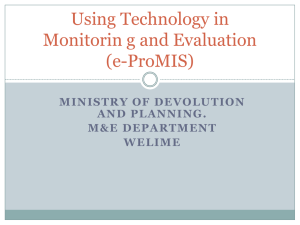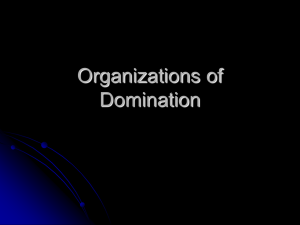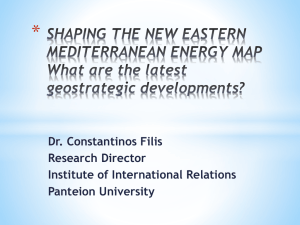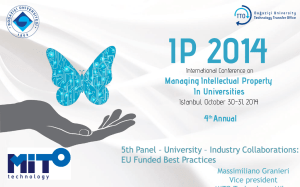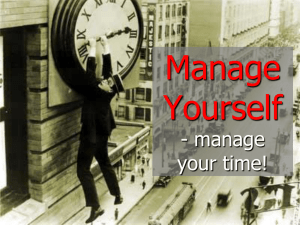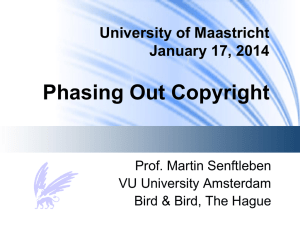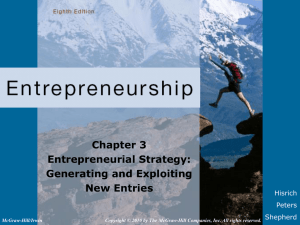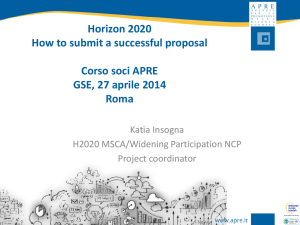A.Kukovecz – Fundamentals of project planning and
advertisement
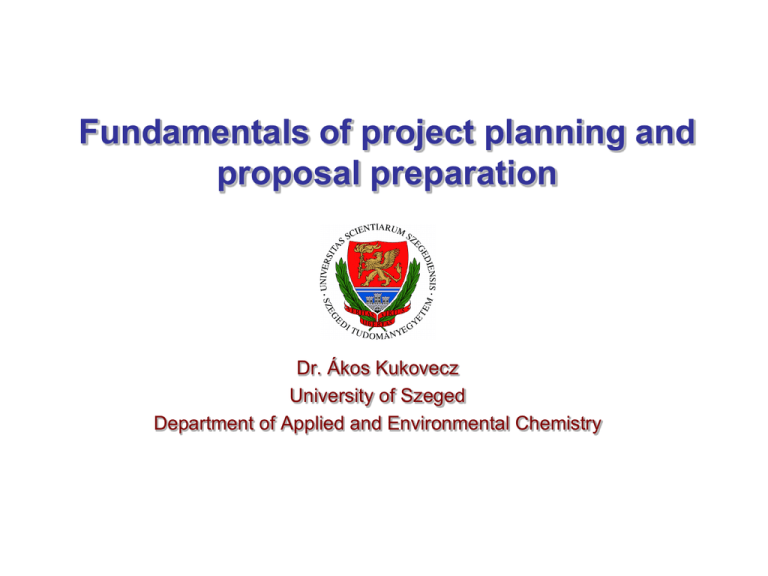
Fundamentals of project planning and proposal preparation Dr. Ákos Kukovecz University of Szeged Department of Applied and Environmental Chemistry Outline • • • • • Difference between project and proposal Preparations for a new project – Identify the topic: what do WE (=person, company, group etc) need? – What are the best available solutions? („state of the art”)? – Where shall we get money (funds) for the realization of the project? (own funds / funding with the help of a proposal) Project planning aids Fundamentals of financial planning What makes a winning proposal besides a good workplan: – Why should they support us and not someone else? Demonstrate your abilities! – What will be the benefits for the funding body if they support us? Matching between our project and their strategic goals – What guarantees that money spent on us is not wasted? Project management planning, risk assessment, exploitation, dissemination.. – Importance of formalities: you MUST stick to the proposal call guidelines, no deviations are allowed! Are we eligible for support at all? Do we have all the signatures, authorization, permissions? Did we respect proposal length criteria? Can we meet the submission deadline? 2/10 Difference between project and proposal • • • Project: – A planned series of actions undertaken in our own organization, – Has well-defined goals / objectives that should be met in a finite amount of time – Assigns certain resources (human and material) to help in reaching these goals. Projects consist of carefully designed series of activities. They have a general life cycle: – Project planning – Project implementation – Project assessment (+ exploitation and dissemination of results) Proposal is a document prepared with a very specific goal: to get resources (usually: financial) that will enable us to realize the project. – Proposal contains the project planning. – FIRST plan the project, THEN prepare proposal! Reverse order is a mistake! Projects are supported by proposals. Project should never be created solely because there is a possibility for proposal submission! 3/10 Outline • • • • • Difference between project and proposal Preparations for a new project – Identify the topic: what do WE (=person, company, group etc) need? – What are the best available solutions? („state of the art”)? – Where shall we get money (funds) for the realization of the project? (own funds / funding with the help of a proposal) Project planning aids Fundamentals of financial planning What makes a winning proposal besides a good workplan: – Why should they support us and not someone else? Demonstrate your abilities! – What will be the benefits for the funding body if they support us? Matching between our project and their strategic goals – What guarantees that money spent on us is not wasted? Project management planning, risk assessment, exploitation, dissemination.. – Importance of formalities: you MUST stick to the proposal call guidelines, no deviations are allowed! Are we eligible for support at all? Do we have all the signatures, authorization, permissions? Did we respect proposal length criteria? Can we meet the submission deadline? 4/10 Identify the topic of your project • • • • It is MORE DIFFICULT to implement a project than to do nothing! Planning, contracts, realization, audits, conflicts of interest etc. Start a project if you can gain more by its implementation than the invested time/effort/money etc. Fundamental question: what do we need? New instrument? Organize a conference? Start new research field? Increase workforce in the lab? Find new markets? Modernize our process technology? … What if you feel that you need improvement but can not exactly identify the field where you should put the project effort? – Flowchart overview of your research methodology, company, processing technology etc. is very useful. – Pareto analysis – Brainstorming – Ishikawa diagram – Radar diagram – SWOT analysis 5/10 Flowchart Steps 1. Identify process starting and ending points. Break long processes into several subprocesses. 2. Describe each process as a series of very simple, basic steps and decisions. 3. Use standard symbols to mark tasks. Rules for flowchart preparation 1. Flowcharts should be compiled by the colleagues who are actually doing the analyized work. 2. Make it possible for everyone to get involved. 3. Allow enough time for flowchart revision, free thinking, criticism etc. 6/10 Flowchart example 7/10 Pizzeria flowchart Open shop Has cash? Take order no yes no Close shop yes Prepare pizza End of working hours? Deliver 8/10 Pareto analysis Goal: select the really important factors from a large set of potential issues. Base: 80-20 rule. 80 % of all problems (effects) are caused by only 20 % of all possible causes Works: on existing technogies (software, experiment, process plant, group of people) where a large amount of data is available Method: chart % distribution of problem occurances as a function of causes Example: Purchase department wasted too much time on asking for corrections of order forms filled by plant foremen. They collected data on the reasons for 1 month: The most common error was that required information was missing. A new Pareto study focused on this issue revealed that the order forms are too complex. They simplified the forms and this has spread up order times. 9/10 Improve pizzeria efficiency using Pareto analysis Problem: on busy evenings some orders took unacceptably long time to complete. To avoid this, they started making pizzas in advance. This improved speed but also increased waste and reduced profit. Data: number of pizza slices in each order on Thursday evening: 02122413121224341432232122122142212122121212 12121222121211222314223222123224224412223221 224212421721223121121222122121222424 10/10 Improve pizzeria efficiency using Pareto analysis 70 60 50 40 30 20 10 0 1 2 3 4 5 6 7 Number of slices in an order 11/10 Improve pizzeria efficiency using Pareto analysis Open shop Has cash? Take order no yes no Close shop Prepare pizza Refill oven yes no End of working hours? Deliver yes 2 more slices available? 12/10 Ishikawa (fishbone) diagram and brainstorming • • Useful for uncovering the causes of a problem (phenomenon) No quantifications! Lists all possible causes but not their probabilities. Ishikawa diagram preparation is easier when (brainstorming): • Objective is to collect to largest possible amount of ideas in a given topic so that new, alternative solutions can emerge. • One of the most frequently utilized creative aids. • Simple method. A brainstorming group can collect lots of ideas in a short time without interfering with the concerned process itself • Possible disadvantages: participants may be frustrated by the status, prestige, behavior and moral judgements (even nonverbal) of the others. Brainstorming sessions MUST be free of criticism and evaluation! 13/10 How to prepare an Ishikawa diagram? 1. 2. Identify the problem and write it to the right (head of the fish). Brainstorm on the major potential causes. Arrange them around a horizontal line (backbone of the fish) and draw the first lines (big bones). When in lack of ideas, use the general categories: Method 3. Manpower Material Metrics Environment Equippment Brainstorm on each major cause. Ask yourself: „How could this happen?” Write answers as smaller bones connecting to the corresponding major bone. Repeat. 14/10 Ishikawa real life example: paediatric nutrition error Bonnabry P et al. Qual Saf Health Care 2005;14:93-98 15/10 Radar (spider web) diagram • • • • Comparison of small and middle sized multivariate datasets Very useful when you must compare products/processes on the basis of very differing variables Useful for revealing deviations of the actual state from the desired/planned statues, and identifying weak points Drawback: does not assist simple „better / worse” type decisions Uniform, strong performance Several weaknesses One weakness Uniform, bad performance 16/10 Spiderweb diagram example: health care system comparison 17/10 SWOT analysis • • • • SWOT = Strengths, Weaknesses, Opportunities, Threats Situation analysis tool, not for direct problem solving. Very useful for project planning. MUST HAVE in a good proposal! Short, compact, interesting. Summary of the detailed information gathered previously. Inner Outer STRENGTHS: Positive factors under our control WEAKNESSES: Negative factors under our control OPPORTUNITIES: Beneficial factors not under our control. Our strengths can be exploited because of them. THREATS: Negative factors from outside that we can not control. May reduce chance of success and increase risks. Positive Negative 18/10 SWOT real-life example: carbon nanotube based chip cooling FP7 project External origin Internal origin Helpful to achieving the objective STRENGTHS - high quality consortium members - good research infrastructure - complementary expertises - experience in EC framework program networking - industrial partners are potential end users of the developed new technology - leading university partner in network can facilitate overseas exploitation OPPORTUNITIES - - Harmful to achieving the objective WEAKNESSES - EC FP networks can react slower to new S/T results than individual RTD units - Financial possibilities of the consortium are limited, third parties will be needed for large scale exploitation - Three RTD partners are universities where low-level researcher (undergraduate and PhD student) fluctuation is high and more training is necessary THREATS electronic industry in serious need of new cooling solutions world CNT production capacity growing fast, machinery costs and unit CNT costs are decreasing health effects of CNTs not fully understood developing technologies that can compete with USA and Asia and are high priority for the EC - alternative cooling methods could be more feasible economically CNT growth mechanism not fully understood. Lower threshold for CNT growth temperature could be difficult to reach. IPR issues may hinder exploitation 19/10 SWOT based strategical planning • • • Our organization (research group, person etc) can always choose from various possible strategies Valid project goal: development, investment, research etc. required by the most important/beneficial strategy. It is very easy to demonstrate why your project is necessary if your proposal contains a good SWOT analysis. S-O strategy: Exploit our opportinities based on our strenghts. W-O strategy: Get rid of our weaknesses by using our strengths. S-T strategy: Protection from threats by relying on our strengths W-T strategy: Protect our organization from threats that target our weaknesses. 20/10 State of the art: the best available solution • • • • • New ideas always have their roots in existing ones. Previous solutions, existing products, existing but not yet satisfied needs, industrial or scientific trends etc. Don’t reinvent hot water! If there is a working solution that suits your needs than it is unnecessary to do research. HOWEVER: adapting the existing solution to our local conditions, introducing it into our technology, introducing a product or technology into our own country etc. Are all valid project goals. Your proposal (project) will be reviewed by experts who know the literature, the technology and the market. If you can’t demonstrate them that YOU also know the field, it will be difficult to convince them that your project would be any good…. How to get on overview of the state of the art? – Ideally, you should really know your field of course…. – Use Google! Search for existing technologies and products, market analysis reports, consumer surveys. – Consult others: instrument manufacturers, solution providers, etc. – Scientific literature: e.g. ISI Web of Science – Patent literature: http://www.freepatentsonline.com/ – Search the project databases of funding agencies http://cordis.europa.eu/ 21/10 Characteristics of a good „state of the art” intro Good state of the art (SotA) introduction: • Does not get lost in details • Non-chronological! Refers to the origin of the field and discusses current situation • Uses visual aids (figures, • Uses data sources, cites data, gives credit to references • Does not focus on the own results of the applicant. However, significant personal accomplishments in the field should be mentioned. • Gives a correct introduction to all available solutions including those that rival the project. Why doing so, it directs attention to the market gap/missing knowledge/develoment opportunity that our project aims at. Objectives and „progress beyond the state of the art”: • Clearly defines the goals we want to achieve by the project • What do we want to accomplish? What results do we expect and on what timescale? • Uses quantitative indicators wherever possible. E.g. „…a chip 40% smaller than previous ones”, or „GC detection limit decrease by 2 orders of magniture” • Makes it clear why WE will succeed where other have not. What is the extra knowledge/novel idea/cooperation opportinuty that we can input to the SotA? 22/10 Where shall we get money for the project? 100% self-financed project: • Nem függünk a pályázat sikerességétől, a támogatási szerződéstől, nincsenek extra törvényi kötelezettségeink (pl. közbeszerzés, fenntartás, disszeminációs kényszer stb). • Does not depend on proposal success or support contracts. No extra obligations (e.g. public tenders, dissemination requirements, project upkeep phase etc) • Allows faster response to new challenges • HOWEVER, you still need to plan the project! Scheduling, work planning, cashflow, risk analysis etc. are all mandatory for your own sake. Funded project: • Funding intensity is seldom 100%. You will still need some funds of your own! • Opens up huge possibilities that are out of your self-financing reach • Huge administrative load, long upkeep phase after funding is stopped, more possibilities for error. You may have to pay back the support and thus go bankrupt • Funding agencies: university, foundations, municipalities, goverment bodies, national scientific or R&D funds, Academy of Sciences, European Union etc. 23/10 Outline • • • • • Difference between project and proposal Preparations for a new project – Identify the topic: what do WE (=person, company, group etc) need? – What are the best available solutions? („state of the art”)? – Where shall we get money (funds) for the realization of the project? (own funds / funding with the help of a proposal) Project planning aids Fundamentals of financial planning What makes a winning proposal besides a good workplan: – Why should they support us and not someone else? Demonstrate your abilities! – What will be the benefits for the funding body if they support us? Matching between our project and their strategic goals – What guarantees that money spent on us is not wasted? Project management planning, risk assessment, exploitation, dissemination.. – Importance of formalities: you MUST stick to the proposal call guidelines, no deviations are allowed! Are we eligible for support at all? Do we have all the signatures, authorization, permissions? Did we respect proposal length criteria? Can we meet the submission deadline? 24/10 Fundamentals of project planning Workplan Risk analysis Exploitation plan Financial plan Project Management structure Publicity Formal requirements Mandatory for proposals 25/10 Tools used for project work planning • • • • • • Problem tree, objective tree, logical framework matrix Identify project start and endpoint Distribute project work between large logical units (work packages) and distribute actual to-do’s within work packages into tasks Project planning overview: Pert diagram Project scheduling overview: Gantt diagram Identify internal progress monitoring tools: products (deliverables) and decision points (milestones) 26/10 Problem analysis • Identifying key problems, constraints opportunities; • Determining cause/effect relationships • Constructing the problem tree 27 Objective analysis • Developing solutions from the identified problem • Identifying means to end effect relationship • Building the objective tree 28/10 Logframe matrix Objectivly veriable indicators Sources of Verification Means Cost Assumptions Overall Objectives Purpose Results Activities PRE 29 CONDITION Logframe matrix Description Projekt leírás ÁLTALÁNOS CÉLOK (overall objectives) PROJEKT CÉLJA (project purpose) Quantitative result indicator Means of verification Objektíven igazolható eredményességi mutató Ellenőrzés forrásai és eszközei Assumptions: out of our control Feltételezések HATÁS INDIKÁTOROK (impact indicators) CÉL INDIKÁTOROK (result indicators) VÁRT EREDMÉNYEK (Expected results v. output) EREDMÉNY INDIKÁTOROK (output indicators) TEVÉKENYSÉGEK (Activities) ESZKÖZÖK (means v. inputs) ELŐFELTÉTELEK 30/10 Logframe strategy levels (first column) What do you want to achieve in your project? ÁTFOGÓ CÉLOK (overall objectives ) PROJEKT CÉLJA (project purpose ) VÁRT EREDMÉNYEK (Expected results v. output) TEVÉKENYSÉGEK (Activities ) High level general objectives linking your project to the strategic goals of the funding agency. The goal that you want to achieve by the end of the project. Results of the project: direct, measureable Activities you will do in your project. 31/10 Logframe result indicators (2nd column) Choose SMART indicators Specific Konkrét Measurable Mérhető Achievable Elérhető, rendelkezésre áll Realistic Reális Time-based Időhöz kötött 32/10 Sources of verification (3rd column) • • • Enter activity cost estimation here (bottom row) Plan the means of verification (reports, audits, etc.) Verified results confirm that the corresponding assumption holds and that the project contributes to overall objectives as planned 33/10 Assumptions in the logframe (4th column) Important requisite? How likely is that the assumption will hold? Leave out yes no Sure Leave out Probable Exercise caution Improbable Can we change the project? Add instruments that can influence this assumption and increase its probability yes no Killer. Stop project planning! 34/10 Logframe matrix design order 35/10 How to read a logframe matrix? Projekt leírás Objektíven igazolható eredményességi mutató Ellenőrzés forrásai és eszközei Feltételezések ÁTFOGÓ CÉLOK (overall objectives) PROJEKT CÉLJA (project purpose) VÁRT EREDMÉNYEK (Expected results v. output) TEVÉKENYSÉGEK (Activities) Pre-requisites 36/10 Logframe matrix example 37 How to design the actual tasks undertaken in the project? • Divide activities into work packages. • A work package should contains: • partial goals, indicators, activities, responsible and participating partners, costs, timing • do not forget to plan for internal project activites: meetings, project related communication, report preparation etc. • Workplan should be both easily understandable and detailed enough. Visual planning aids (tables, time charts, Gantt and Pert diagrams etc) should be used! 38/10 Work packages: the building blocks of the project report Results of previous WPs Task 1 Task 2 Human resources Material or product to be passed to later WPs Task 3 Financial resources Time prototype Work package ## Product(deliverable) Some WPs include milestones. Do NOT mix up milestones and deliverables! Milestone: allows the assessment of overall project progress. At a milestone you must decide if the project has made the targeted progress in the given time (e.g. „device should be 60 % ready”) and make a decision that affects forthcoming project implementation: shall we continue the project or stop? Should we work on research direction ‘A’ or ‘B’? Milestones are very important for proposals, because the funding agency will decide on the continuation/stopping of our funds on the basis of our milestone realization progress. 39/10 Example: details of a work package Start date Participants involved Objectives of the WP Detailed description of the planned work down to the task level. Outputs of the WP: deliverables and milestones 40/10 Example: work package overview in a real project 41/10 Relationship between work packages: Pert diagram „light” 42/10 Scheduling of work packages: Gantt diagram Workpackages Project time measured in calendar months Gray lines mark the duration of workpackages. Deliverables (D) and milestones (M) are also marked on the chart. 43/10 PERT method PERT: Program Evaluation and Review Technique Earliest start time Duration Earliest finish time Activity code and identification Latest start time Maximum time reserve Allows calculation of: - earliest possible start of project - latest possible finish of project - time reserve - critical project path Latest finish time 44/10 Outline • • • • • Difference between project and proposal Preparations for a new project – Identify the topic: what do WE (=person, company, group etc) need? – What are the best available solutions? („state of the art”)? – Where shall we get money (funds) for the realization of the project? (own funds / funding with the help of a proposal) Project planning aids Fundamentals of financial planning What makes a winning proposal besides a good workplan: – Why should they support us and not someone else? Demonstrate your abilities! – What will be the benefits for the funding body if they support us? Matching between our project and their strategic goals – What guarantees that money spent on us is not wasted? Project management planning, risk assessment, exploitation, dissemination.. – Importance of formalities: you MUST stick to the proposal call guidelines, no deviations are allowed! Are we eligible for support at all? Do we have all the signatures, authorization, permissions? Did we respect proposal length criteria? Can we meet the submission deadline? 45/10 Fundamentals of financial planning • • • Assign adequate resources to each work package and each partner, otherwise the project can not be implemented. Resources: – Human – Stationery (e.g. instruments) – Consumables (e.g. chemicals, gases, paper, AFM tip) – Services and other costs: travel, conference registration, post, representation Pay attention to: – Overhead costs claimed by the host organization (e.g. university overhead – Eligibility and calculation of taxes (e.g. VAT), bank costs and customs fees – Rules for personnel costs: allowed contract types, daily allowances, social security payments by the host and by the person etc. – Compulsory service fees: audit costs, tendering costs, banking costs – When purchasing stationery (e.g. new instrument), check if the full cost is eligible in the project or not? It is possible that the project can only pay depreciation during project lifetime, taking into account the % usage distribution as well – What are the eligible costs? Should non-eligible ones be included in the total budget? What is the financing intensity for eligible cost types (e.g. R&D 75 %, demonstration 50 %, management 100 %) 46/10 Human resource planning Person month (person day, person hour etc): the amount of work expected in the specified timeframe from a person working full time on the implementation of the project. If you don’t have a detailed project budget, person month planning is a good starting point for estimating the other cost types proportionally and come up with a reasonable project budget. a. Hungary: 7000-10000 EUR/person month is generally acceptable for EU projects. Personnel cost is the most crucial part of project budgets usually! Consider the personnel costs of a very small 3 year research project: Employee Months Monthly payment (HUF) Monthly employer costs (social security) (27 %) Total (HUF) 1 postdoc 36 220000 59400 10 058 400 1 administrator, 25 % work time 9 170000 45900 1 943 100 4 students, payment only for the 2 summer months annually 4x2x3=24 60000 16200 1 828 800 13 830 300 48293 EUR or 51827 AZN 47/10 Person month planning aids Work load diagram based on PERT: Person month overview table: 48/10 Outline • • • • • Difference between project and proposal Preparations for a new project – Identify the topic: what do WE (=person, company, group etc) need? – What are the best available solutions? („state of the art”)? – Where shall we get money (funds) for the realization of the project? (own funds / funding with the help of a proposal) Project planning aids Fundamentals of financial planning What makes a winning proposal besides a good workplan: – Why should they support us and not someone else? Demonstrate your abilities! – What will be the benefits for the funding body if they support us? Matching between our project and their strategic goals – What guarantees that money spent on us is not wasted? Project management planning, risk assessment, exploitation, dissemination.. – Importance of formalities: you MUST stick to the proposal call guidelines, no deviations are allowed! Are we eligible for support at all? Do we have all the signatures, authorization, permissions? Did we respect proposal length criteria? Can we meet the submission deadline? 49/10 Proposal impact: what shall WE gain by implementing the project? • • If you can not demonstrate that the project will be beneficial for you, noone will take you seriously! Don’t be shy, identify your expected benefits clearly! Use aids to support your argument: – Demonstrate scientific novelty by literature research, preliminary experiments (fundamental research) – Demonstrate feasibility of concept by prototype, pilot study, preliminary experiments (applied R&D) – Demonstrate the lack of suitable instrumentation AND the existing measurement needs in your region (when applying for new instrument) – Present return of investment calculations (technological develoment) – Present market research and analysis data (new product) 50/10 Proposal impact: why should they chose US and not someone else for funding? • • • Quality of the host: – Research infrastructure (labspace, instrumentation) – Financial stability (balance sheets) – Project experience (similar previous projects completed successfully) In case of consortium proposal (more than one organization in proposal): – Demonstrate complementary competences. Overlapping expertise (e.g. two synthesis labs preparing the same chemical) should be avoided. Complementarity should be emphasized – Demonstrate the presence of the full innovation chain in the project. Fundamental resarch institute, applied R&D lab, raw product manufacturer, consumer product manufacturer, end user. – Geographical location of partners should match the strategic goals of the funding agency. Use many countries in EU proposals, use local partners in regional ones. Personal qualities of the participants – CV, list of publications, previous project experience – Demonstrate why a particular person is specifically suitable for the tasks assigned to him in the project (e.g. project leader, exploitation manager etc.) 51/10 Proposal impact: what can THEY gain by supporting us? • • • All funding bodies have their own strategic goals. They open proposal calls to achieve these goals. E.g. research agency = increase knowledge, EU SME = improve R&D in SMEs, government = create jobs, improve environment You MUST get acquinted with these strategic goals and demonstrate in the proposal that your project will enable the funder to achieve its goals. Useful documents: mission statements, proposal call texts, EU work programs „Monitoring indicators”: project results in a quantitative way that FITS to the funder’s own goals. – BAD monitoring indicator: „we functionalize 20 g carbon nanotubes” – BAD monitoring indicator: „we shall run and document 328 experiments” – GOOD monitoring indicator: „create 2 new jobs”, „publish 5 new papers”, „increase sales from measurement services by 10000 EUR”, „increase the use of recycled paper in office by 40 %” etc. 52/10 Proposal: guarantees for successful project implementation • Project management: hierarchical, one leader, clearly defined responsibilties • In your proposal you should discuss: • Decision making mechanisms • Methods of continuous internal progress assessment • Risk analysis and contingency planning • Conflict resultion planning • Exploitation plans and claims. Intellectual Property Right (IPR) issues • Dissemination and outreach activities 53/10 Decision making schemes Risk analysis and contingency planning Intellectual Property Rights • • • • IPR are very important It usually takes a separate contract (e.g. consortium agreement) to regulate them HOWEVER, you must demonstrate that you are aware of IPR: – Expected protectable results – Background claims – Foreground (new project results) ownership – How will pay for patenting Funding agency may have its own IPR policy that you must respect Dissemination and outreach activities • • • • • • • • Demonstrating results to the general public is VERY important for the EU. Plan dissemination activities – Publications, conference appearances, seminars Plan outreach activities: – Mass media appearances, journal newsflashes, homepage, YouTube channel, project representation at science fairs, open university days etc. Put REAL EFFORT into planning! Name the target journals and conferences. Estimate the number of news releases in advance! Support your estimations by data (e.g. your previous similar activities) Demonstrate your own motivation for outreach activities. Estimate the size, interests and scientific background of your target groups (e.g. general adult citizens, industrial sector representatives, politicians, high school students, small kids etc.) and design dedicated outreach activity for each target group! Update homepage regularly. Keep a running list of all dissemination and outreach activities. It will be MUCH more difficult to compile it at the end of the project! Respect the public. Most of the time, you are using public money! 57/10 Proposal: formal requirements • • • • • • • WAY MORE important than you would think! There are always more applications than money, so it is easiest to discard proposals containing formal errors Read the call text, guidelines for applicants and all related documents carefully and more than once to avoid working in vain Are we eligible to submit a proposal? Does our proposal include all compulsory elements? Workplan is just one of many! Company registration, signature sheets, balance copy, permission etc Does our proposal meet the formal requirements? Workplan length, company stamped signatures, each page signed, file format OK, number of copies expected etc Do the electronic and the paper version match? Is the electronic version file readable, virus free and non-corrupt? Submission deadline? Posting date or received date? You can tweak the workplan until the last moment, but official documents take long time (weeks even) to obtain. Calculate with this time! 58/10 Thank you Thank you for your attention, happy project planning! 59/10
